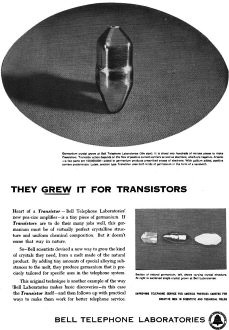|
January 1954 Radio-Electronics
 [Table of Contents] [Table of Contents]
Wax nostalgic about and learn from the history of early electronics.
See articles from Radio-Electronics,
published 1930-1988. All copyrights hereby acknowledged.
|
Accuse me of whatever you
want, but I sure wish a lot of the early and middle 20th century stalwart industrial
and technology companies were still around. Some exist as a remnant of their former
selves after having been absorbed into some other company - often a foreign concern.
Others have been broken into separate parts with new names (e.g., Hewlett Packard
into HP & Agilent/Keysight) while losing their founding identities. A few have
retained their name (or part of it) while being owned and managed by foreign companies.
Bell Systems
is probably the poster child and most famous company forced to surrender its identity
due to a court-ordered breakup following a monopoly lawsuit. As I have mentioned
many times before, Bell is responsible for America's dominance in telecommunications
in the 20th century. In this 1954 issue of Radio-Electronics magazine announces
Bell Telephone Labs' development of ultra pure germanium crystals for fabricating
semiconductors. Be sure to check the huge list of Bell Telephone full-page advertisements
from these vintage magazines.
Bell Telephone Laboratories - Germanium Crystal
 Germanium crystal grown at Bell Telephone
Laboratories (life size). It is sliced into hundreds of minute pieces to make Transistors.
Transistor action depends on the flow of positive current-carriers as well as electrons,
which are negative. Arsenic - a few parts per 100,000,000 - added to germanium produces
prescribed excess of electrons. With gallium added, positive carriers predominate.
Latest junction type Transistor uses both kinds of germanium in the form of a sandwich. Germanium crystal grown at Bell Telephone
Laboratories (life size). It is sliced into hundreds of minute pieces to make Transistors.
Transistor action depends on the flow of positive current-carriers as well as electrons,
which are negative. Arsenic - a few parts per 100,000,000 - added to germanium produces
prescribed excess of electrons. With gallium added, positive carriers predominate.
Latest junction type Transistor uses both kinds of germanium in the form of a sandwich.
They Grew
it for Transistors
Heart of a Transistor - Bell Telephone Laboratories' new pea-size amplifier -
is a tiny piece of germanium. If Transistors are to do their many jobs well, this
germanium must be of virtually perfect crystalline structure and uniform chemical
composition. But it doesn't come that way in nature.
So - Bell scientists devised a new way to grow the kind of crystals they need,
from a melt made of the natural product. By adding tiny amounts of special alloying
substances to the melt, they produce germanium that is precisely tailored for specific
uses in the telephone system.
This original technique is another example of the way Bell Laboratories makes
basic discoveries - in this case the Transistor itself - and then follows up with
practical ways to make them work for better telephone service.
Section of natural germanium, left, shows varying crystal structure. At right
is sectioned single crystal grown at Bell Laboratories.
Improving Telephone Service for America Provides Careers for Creative Men in
Scientific and Technical Fields
Bell Telephone Laboratories
Posted March 3, 2022
| Bell Telephone
Laboratories Infomercials |
-
The Future Holds Great Promise
- August 1949 Popular Science
-
Waveguide: 7/47 Popular Mechanics
-
Wire Wrapping - 10/1953 Popular Science
-
X-Rays, 4/60 Radio-electronics
- The Battle of
the Atoms, 4/1948 Radio News
-
The Transistor, 6/1952 Radio-Electronics
- 90-Mile Laboratory
for Telephone and Television, 6/1945 Radio News
-
Wire-Wrap, 10/53 Radio-Electronics
-
EDT Crystals, 10/47 Radio-Craft
- Germanium Refining,
5/54 Radio & TV News
- Crystal Timekeeping,
1/46 Radio News
- Transatlantic
Cable, 11/56 Radio & Television News
- Pipe Circuits,
11/48 Radio & Television News
-
Coaxial
Electron Tube, 6/54 Radio & Television News
- Thermocompression
Wire Bonding, 3/58 Radio News
-
Radio Relay Stations, 8/52 Radio & Television News
- Isolators,
6/56 Radio & Television News
- Punch
Cards, 3/55 Radio & Television News
-
Over-the-Horizon
Communications, 10/55 Radio & Television News
- Memory
Devices, 2/58 Radio & TV News
-
Adventure in Silicon, 5/55 Radio & Television News
- Pipes of Progress,
6/55 Radio & Television News
-
Project Echo, 11/60 Electronics World
|
-
Jacques Bernoulli, February 1960 Radio-Electronics
-
Type-O Carrier System, October 1952 Radio-Electronics
-
Electron Microscope, 4/1952 Radio-Electronics
-
Thermistor, 11/1946 Radio-Craft
-
Germanium Crystal, 1/1954 Radio-Electronics
-
Lens
Antenna, 5/46 Radio-Craft
- Quality Control, 6/46
Radio News Article
- Transcontinental
Radio-Relay, 10/51 Radio & TV News
- Solar
Battery, 7/54 Radio & Television News
-
Germanium Transistors, 1/54 Radio & Television News
- Cavity
Magnetron, 10/45 Radio News
-
The Cableman, 10/49 Radio & Television News
-
Coaxial Cable, 12/49 Radio & Television News
-
Tin
Whiskers, 12/55 Radio & Television News
- Relay
Contact Inspection, 7/55 Radio & Television News
- Transistor's
10th Anniversary, 6/58 Radio & Television News
-
Wire
Wrapping, 10/53 Radio & Television News
- Junction
Diode Amplifier, 11/58 Radio News
-
Nobel Prize Winners, 2/57 Radio & Television News
-
Diode Speeds Voices, 8/58 Popular Electronics
-
Microwave Relays, 7/59 Electronics World
|
|

